Prognostic Models Using Machine Learning Algorithms and Treatment Outcomes of Occult Breast Cancer Patients
Abstract
1. Introduction
2. Materials and Methods
2.1. Data Source and Study Design
2.2. Machine Learning Models
2.3. LR
2.4. SVM
2.5. ID3 and RF
2.6. XGBoost Model
2.7. kNN
2.8. Statistical Analysis
3. Results
3.1. Clinical Characteristics of OBC Patients
3.2. Univariate and Multivariate Cox Regression Analysis
3.3. Constructing and Assessing Predictive Models for the Estimation of OBC Patients’ Prognosis
3.4. Benefits of Chemotherapy in OBC Patients Subdivided by Molecular Subtype
3.5. Benefits of Surgery for OBC Patients Subdivided by Molecular Subtype
4. Discussion
5. Conclusions
Supplementary Materials
Author Contributions
Funding
Institutional Review Board Statement
Informed Consent Statement
Data Availability Statement
Acknowledgments
Conflicts of Interest
References
- Fayanju, O.M.; Jeffe, D.B.; Margenthaler, J.A. Occult primary breast cancer at a comprehensive cancer center. J. Surg. Res. 2013, 185, 684–689. [Google Scholar] [CrossRef] [PubMed]
- Hotta, M.; Khurana, M.; Sung, M.; O’Connor, V.V. Understanding the Biology of Occult Breast Cancer: Examination of 31 Cases Reveals Aggressive Behavior. Am. Surg. 2020, 86, 116–118. [Google Scholar] [CrossRef]
- Zhang, D.; Zhai, J.; Li, L.; Wu, Y.; Ma, F.; Xu, B. Prognostic Factors and a Model for Occult Breast Cancer: A Population-Based Cohort Study. J. Clin. Med. 2022, 11, 6804. [Google Scholar] [CrossRef]
- Halsted, W.S. The Results of Radical Operations for the Cure of Carcinoma of the Breast. Ann. Surg. 1907, 46, 1–19. [Google Scholar] [CrossRef] [PubMed]
- Walker, G.V.; Smith, G.; Perkins, G.H.; Oh, J.L.; Woodward, W.; Yu, T.-K.; Hunt, K.K.; Hoffman, K.; Strom, E.A.; Buchholz, T.A. Population-based analysis of occult primary breast cancer with axillary lymph node metastasis. Cancer 2010, 116, 4000–4006. [Google Scholar] [CrossRef] [PubMed]
- Ofri, A.; Moore, K. Occult breast cancer: Where are we at? Breast 2020, 54, 211–215. [Google Scholar] [CrossRef] [PubMed]
- Ge, L.-P.; Liu, X.-Y.; Xiao, Y.; Gou, Z.; Zhao, S.; Jiang, Y.-Z.; Di, G.-H. Clinicopathological characteristics and treatment outcomes of occult breast cancer: A SEER population-based study. Cancer Manag. Res. 2018, 10, 4381–4391. [Google Scholar] [CrossRef]
- Huang, K.-Y.; Zhang, J.; Fu, W.-F.; Lin, Y.-X.; Song, C.-G. Different Clinicopathological Characteristics and Prognostic Factors for Occult and Non-occult Breast Cancer: Analysis of the SEER Database. Front. Oncol. 2020, 10, 1420. [Google Scholar] [CrossRef]
- Ping, S.; Ming, W.H.; Bin, S.H.; Wen, W.D.; Cheng, Q.; Jun, C.C.; Bin, H.Y.; Jian, C.Z. Comparison of clinical characteristics between occult and non-occult breast cancer. J. BUON 2014, 19, 662–666. [Google Scholar]
- Jackson, B.; Scott-Conner, C.; Moulder, J. Axillary metastasis from occult breast carcinoma: Diagnosis and management. Am. Surg. 1995, 61, 431–434. [Google Scholar]
- Hessler, L.K.; Molitoris, J.K.; Rosenblatt, P.Y.; Bellavance, E.C.; Nichols, E.M.; Tkaczuk, K.H.R.; Feigenberg, S.J.; Bentzen, S.M.; Kesmodel, S.B. Factors Influencing Management and Outcome in Patients with Occult Breast Cancer with Axillary Lymph Node Involvement: Analysis of the National Cancer Database. Ann. Surg. Oncol. 2017, 24, 2907–2914. [Google Scholar] [CrossRef] [PubMed]
- Man, X.; Xu, H.; Wang, H.; Zhao, J.; Chen, X.; Yin, S.; Tan, Q.; Huang, J.; Sun, S.; Zhou, D.; et al. Survival analysis and nomogram for early-stage occult breast cancer with positive lymph nodes based on the SEER database. Ann. Transl. Med. 2022, 10, 1351. [Google Scholar] [CrossRef] [PubMed]
- Sajda, P. Machine Learning for Detection and Diagnosis of Disease. Annu. Rev. Biomed. Eng. 2006, 8, 537–565. [Google Scholar] [CrossRef]
- Tran, K.A.; Kondrashova, O.; Bradley, A.; Williams, E.D.; Pearson, J.V.; Waddell, N. Deep learning in cancer diagnosis, prognosis and treatment selection. Genome Med. 2021, 13, 152. [Google Scholar] [CrossRef] [PubMed]
- Li, C.; Liu, M.; Li, J.; Wang, W.; Feng, C.; Cai, Y.; Wu, F.; Zhao, X.; Du, C.; Zhang, Y.; et al. Machine learning predicts the prognosis of breast cancer patients with initial bone metastases. Front. Public Health 2022, 10, 1003976. [Google Scholar] [CrossRef] [PubMed]
- Lipkova, J.; Chen, R.J.; Chen, B.; Lu, M.Y.; Barbieri, M.; Shao, D.; Vaidya, A.J.; Chen, C.; Zhuang, L.; Williamson, D.F.; et al. Artificial intelligence for multimodal data integration in oncology. Cancer Cell 2022, 40, 1095–1110. [Google Scholar] [CrossRef] [PubMed]
- Tsai, C.; Zhao, B.; Chan, T.; Blair, S.L. Treatment for occult breast cancer: A propensity score analysis of the National Cancer Database. Am. J. Surg. 2019, 220, 153–160. [Google Scholar] [CrossRef]
- Terada, M.; Miyashita, M.; Kumamaru, H.; Miyata, H.; Tamura, K.; Yoshida, M.; Ogo, E.; Nagahashi, M.; Asaga, S.; Kojima, Y.; et al. Surgical treatment trends and identification of primary breast tumors after surgery in occult breast cancer: A study based on the Japanese National Clinical Database—Breast Cancer Registry. Breast Cancer 2022, 29, 698–708. [Google Scholar] [CrossRef]
- Johnson, H.M.; Irish, W.; Vohra, N.A.; Wong, J.H. The effect of local therapy on breast cancer-specific mortality of women with occult breast cancer and advanced nodal disease (N2/N3): A population analysis. Breast Cancer Res Treat 2019, 177, 155–164. [Google Scholar] [CrossRef]
- Zhao, Z.; Zhang, T.; Yao, Y.; Lu, X. Clinicopathological characteristics and treatment outcomes of occult breast cancer: A population-based study. BMC Surg. 2022, 22, 143. [Google Scholar] [CrossRef]
- Kim, B.H.; Kwon, J.; Kim, K. Evaluation of the Benefit of Radiotherapy in Patients with Occult Breast Cancer: A Population-Based Analysis of the SEER Database. Cancer Res. Treat. 2018, 50, 551–561. [Google Scholar] [CrossRef] [PubMed]
- Domínguez-Almendros, S.; Benítez-Parejo, N.; Gonzalez-Ramirez, A. Logistic regression models. Allergol. Immunopathol. (Madr.) 2011, 39, 295–305. [Google Scholar] [CrossRef]
- Huang, S.; Cai, N.; Pacheco, P.P.; Narandes, S.; Wang, Y.; Xu, W. Applications of Support Vector Machine (SVM) Learning in Cancer Genomics. Cancer Genom. Proteom. 2018, 15, 41–51. [Google Scholar] [CrossRef]
- Kourou, K.; Exarchos, T.P.; Exarchos, K.P.; Karamouzis, M.V.; Fotiadis, D.I. Machine learning applications in cancer prognosis and prediction. Comput. Struct. Biotechnol. J. 2015, 13, 8–17. [Google Scholar] [CrossRef] [PubMed]
- Yu, Y.; Tran, H. An XGBoost-Based Fitted Q Iteration for Finding the Optimal STI Strategies for HIV Patients. IEEE Trans. Neural Netw. Learn. Syst. 2022, 1–9. [Google Scholar] [CrossRef] [PubMed]
- Zhang, S.; Li, X.; Zong, M.; Zhu, X.; Wang, R. Efficient kNN Classification With Different Numbers of Nearest Neighbors. IEEE Trans. Neural Netw. Learn. Syst. 2017, 29, 1774–1785. [Google Scholar] [CrossRef]
- Kane, L.T.; Fang, T.; Galetta, M.S.; Goyal, D.K.; Nicholson, K.J.; Kepler, C.K.; Vaccaro, A.R.; Schroeder, G.D. Propensity Score Matching: A Statistical Method. Clin. Spine. Surg. 2020, 33, 120–122. [Google Scholar] [CrossRef]
- Barakat, A.; Mittal, A.; Ricketts, D.; Rogers, A.B. Understanding survival analysis: Actuarial life tables and the Kaplan–Meier plot. Br. J. Hosp. Med. 2019, 80, 642–646. [Google Scholar] [CrossRef]
- Austin, P.C.; Harrell, F.E., Jr.; van Klaveren, D. Graphical calibration curves and the integrated calibration index (ICI) for survival models. Stat. Med. 2020, 39, 2714–2742. [Google Scholar] [CrossRef]
- Vickers, A.J.; Cronin, A.M.; Elkin, E.B.; Gonen, M. Extensions to decision curve analysis, a novel method for evaluating diagnostic tests, prediction models and molecular markers. BMC Med. Inform. Decis. Mak. 2008, 8, 53. [Google Scholar] [CrossRef]
- Wild, J.B.; Thrush, S.; Vidya, R. What can National Registry data tell us about occult breast cancer? Chin. Clin. Oncol. 2019, 8, S15. [Google Scholar] [CrossRef] [PubMed]
- de Bresser, J.; de Vos, B.; van der Ent, F.; Hulsewé, K. Breast MRI in clinically and mammographically occult breast cancer presenting with an axillary metastasis: A systematic review. Eur. J. Surg. Oncol. (EJSO) 2010, 36, 114–119. [Google Scholar] [CrossRef] [PubMed]
- Ahmed, M.; Douek, M. The management of screen-detected breast cancer. Anticancer. Res. 2014, 34, 1141–1146. [Google Scholar]
- Kim, H.; Park, W.; Kim, S.S.; Ahn, S.J.; Kim, Y.B.; Kim, T.H.; Kim, J.H.; Choi, J.-H.; Park, H.J.; Chang, J.S.; et al. Outcome of breast-conserving treatment for axillary lymph node metastasis from occult breast cancer with negative breast MRI. Breast 2020, 49, 63–69. [Google Scholar] [CrossRef] [PubMed]
- Wang, J.; Zhang, Y.F.; Wang, X.; Wang, J.; Yang, X.; Gao, Y.Q.; Fang, Y. Treatment outcomes of occult breast carcinoma and prognostic analyses. Chin. Med. J. 2013, 126, 3026–3029. [Google Scholar] [PubMed]
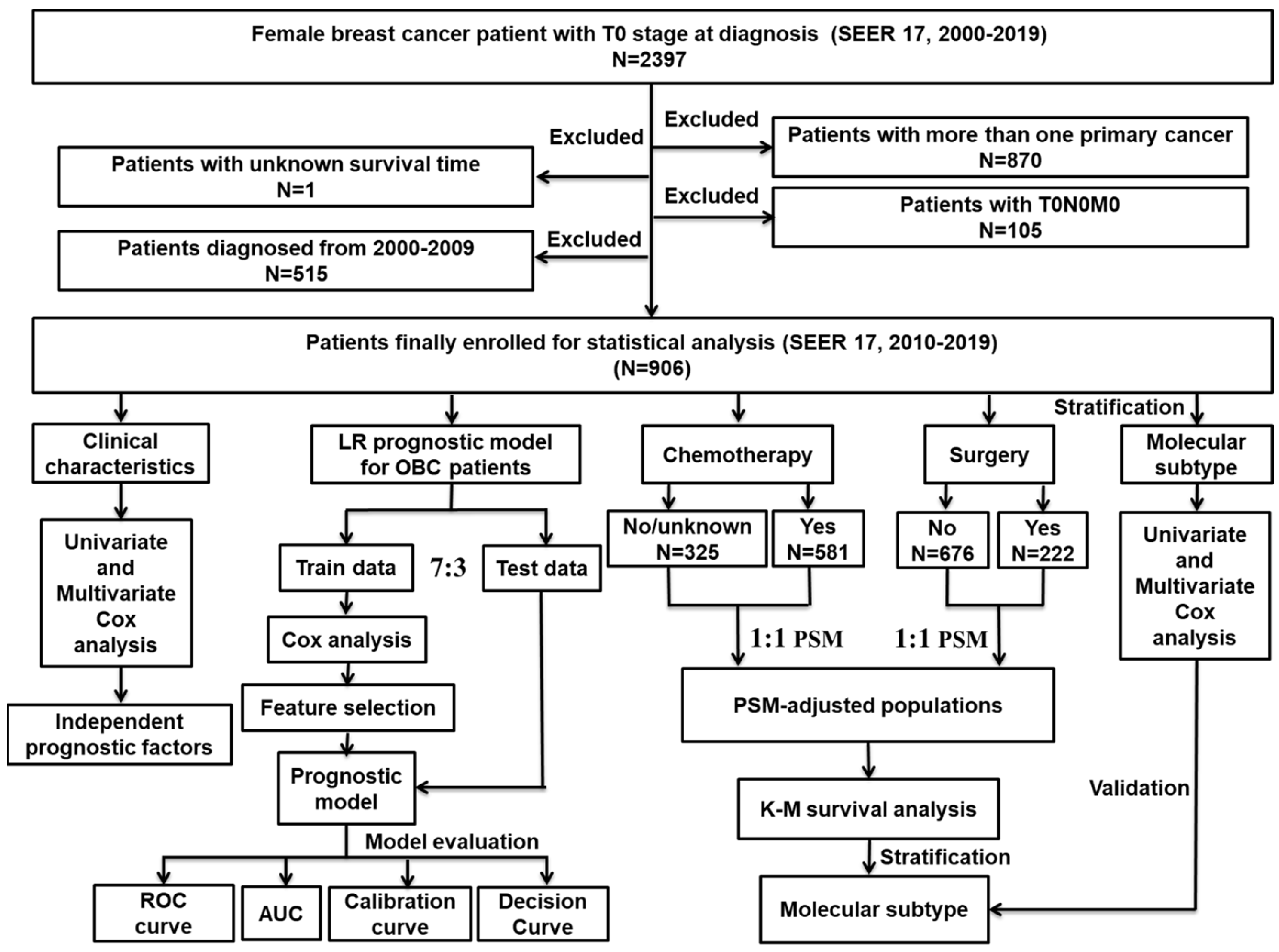
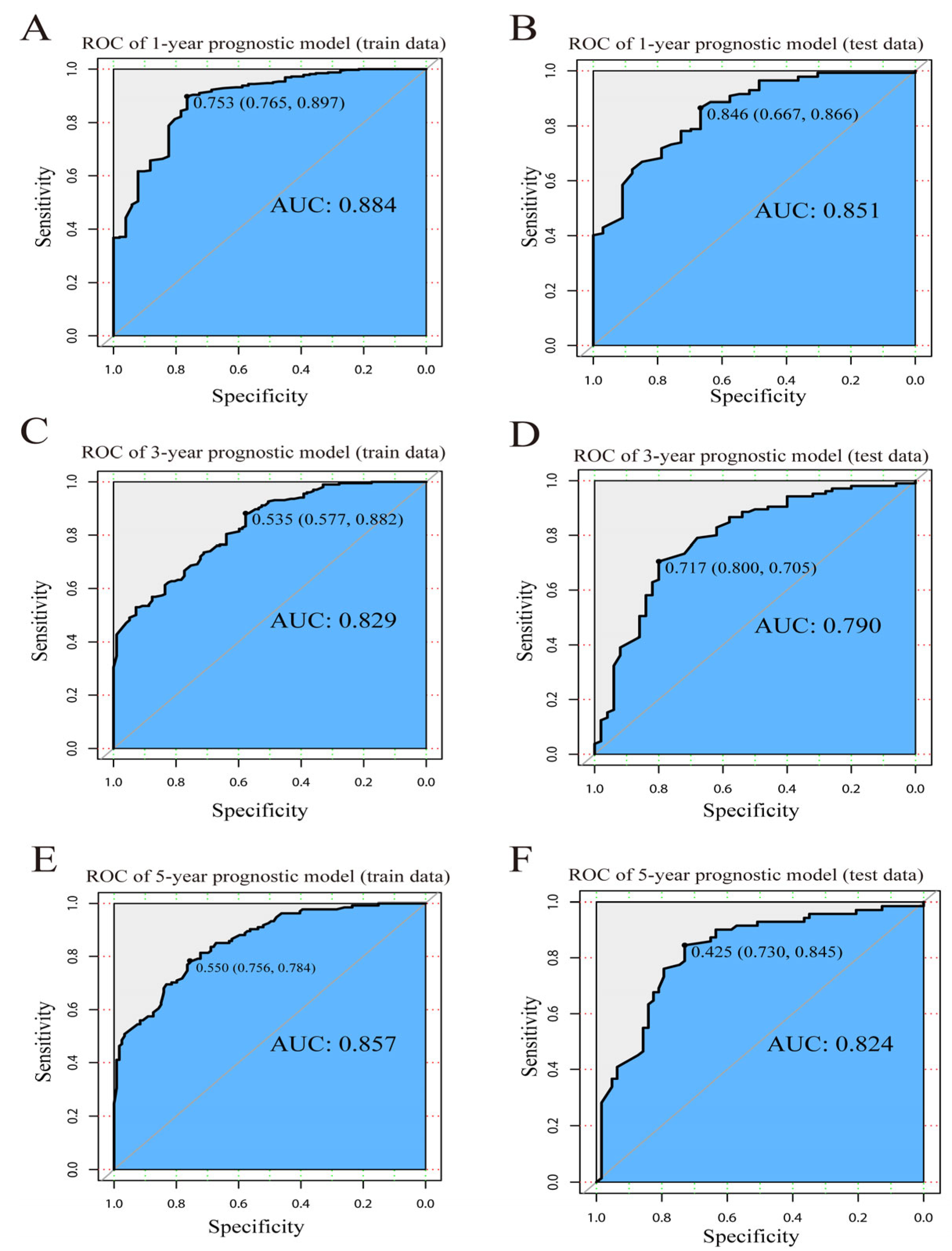
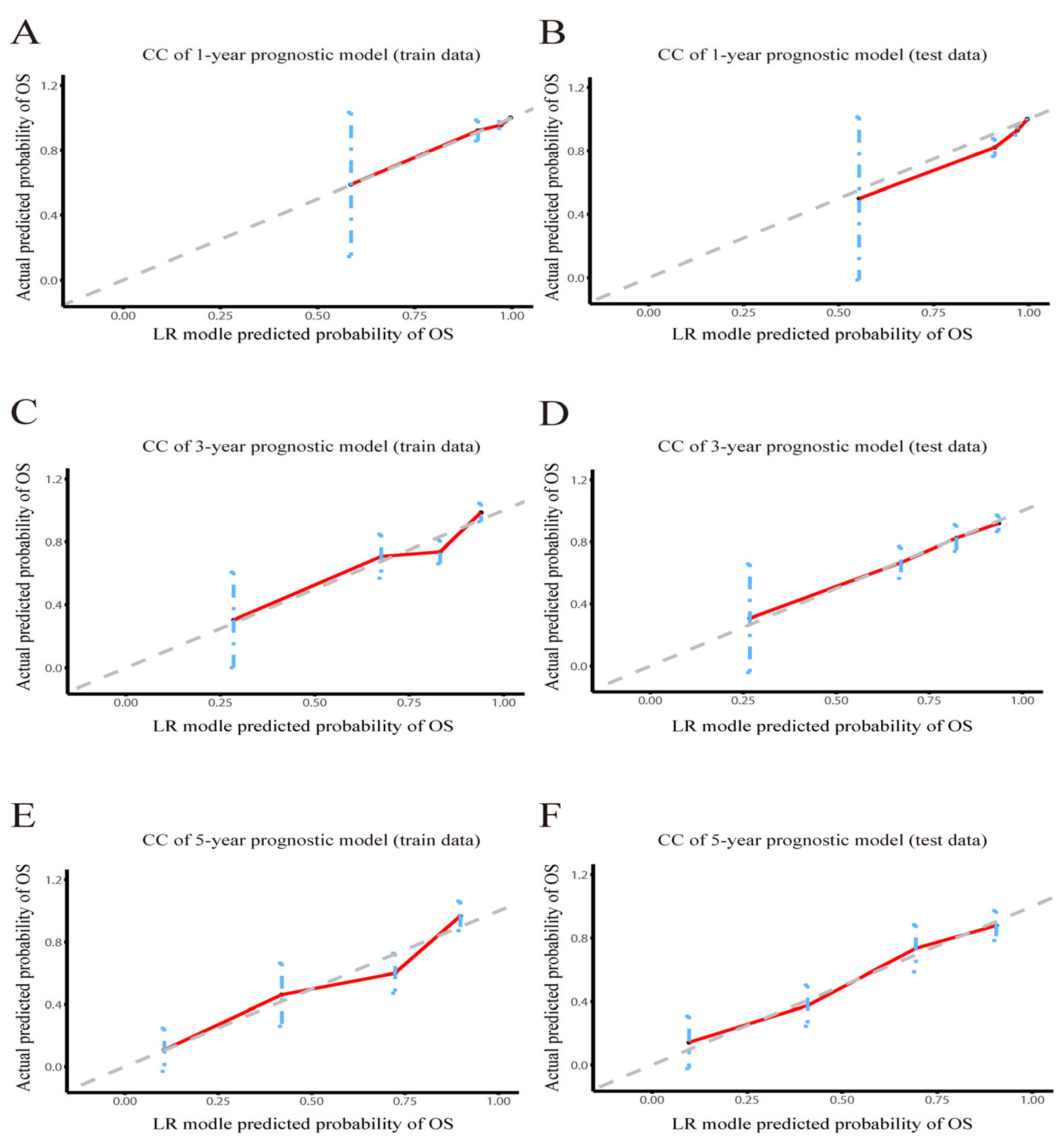
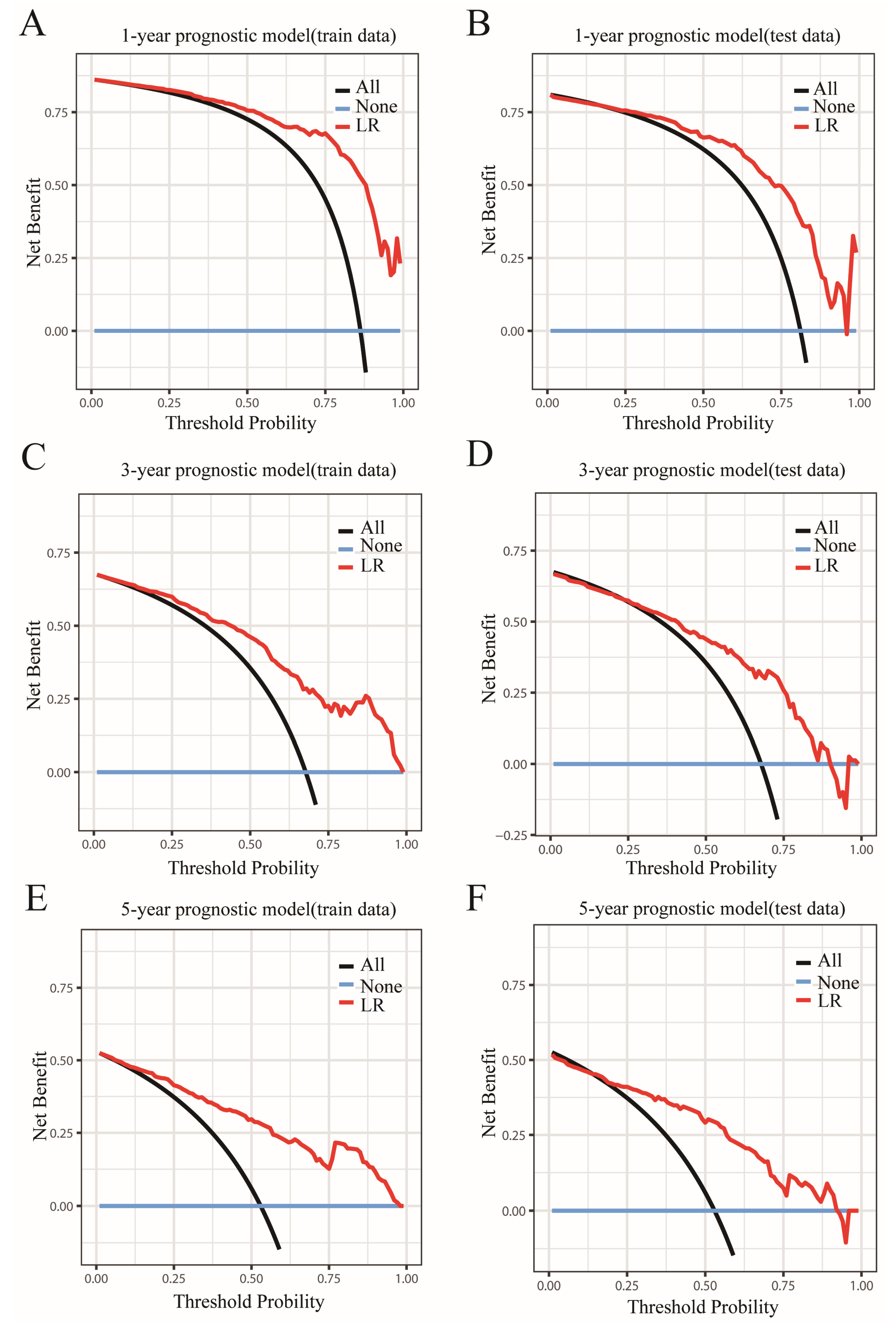
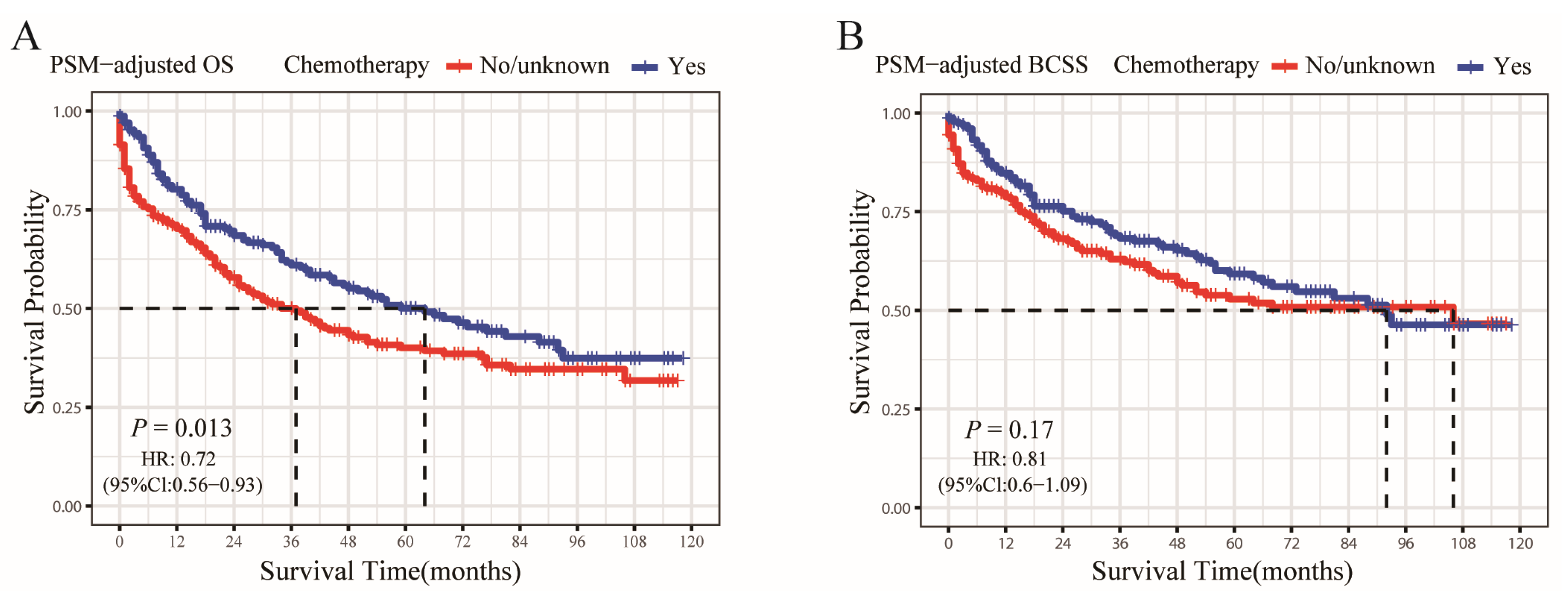
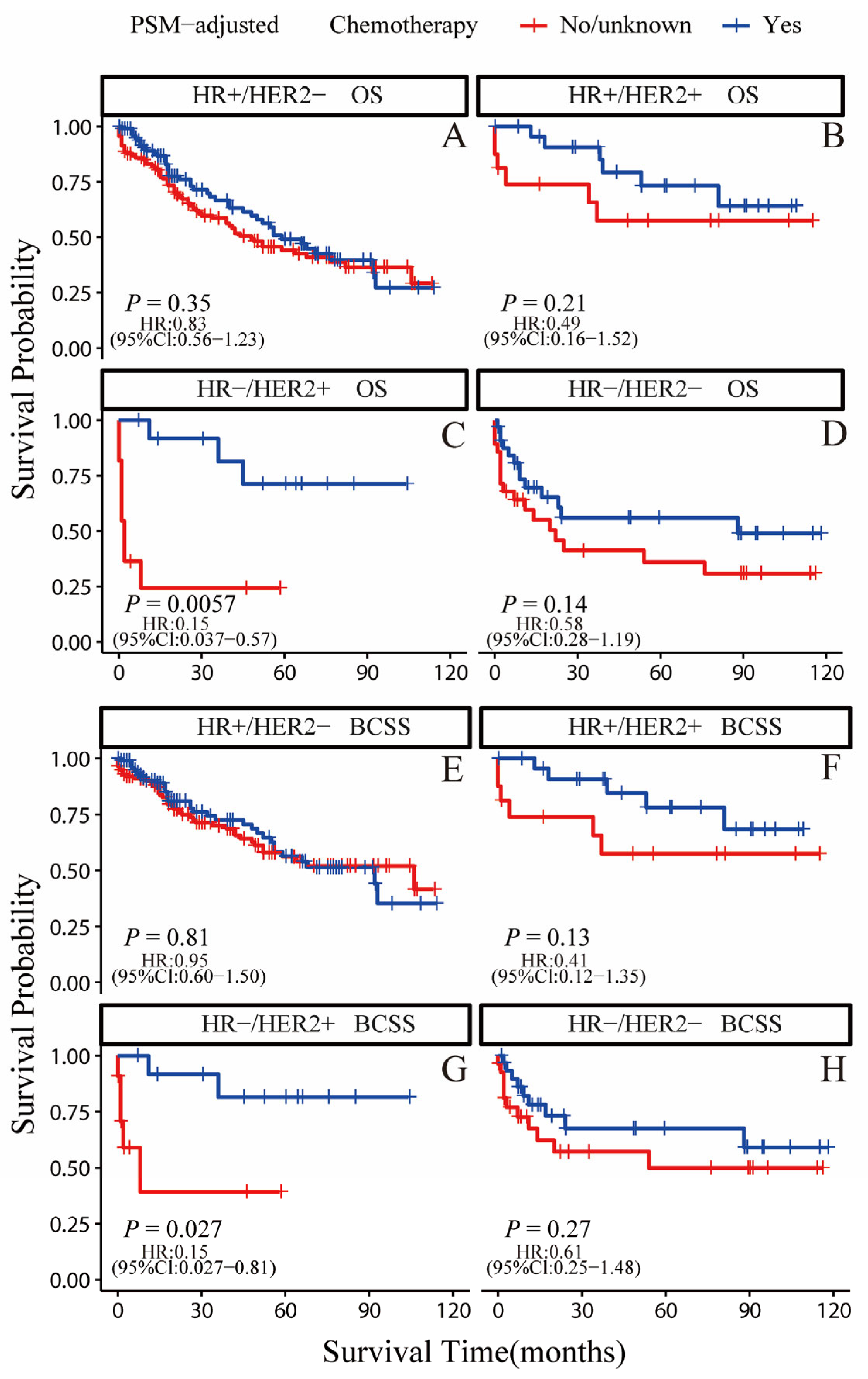
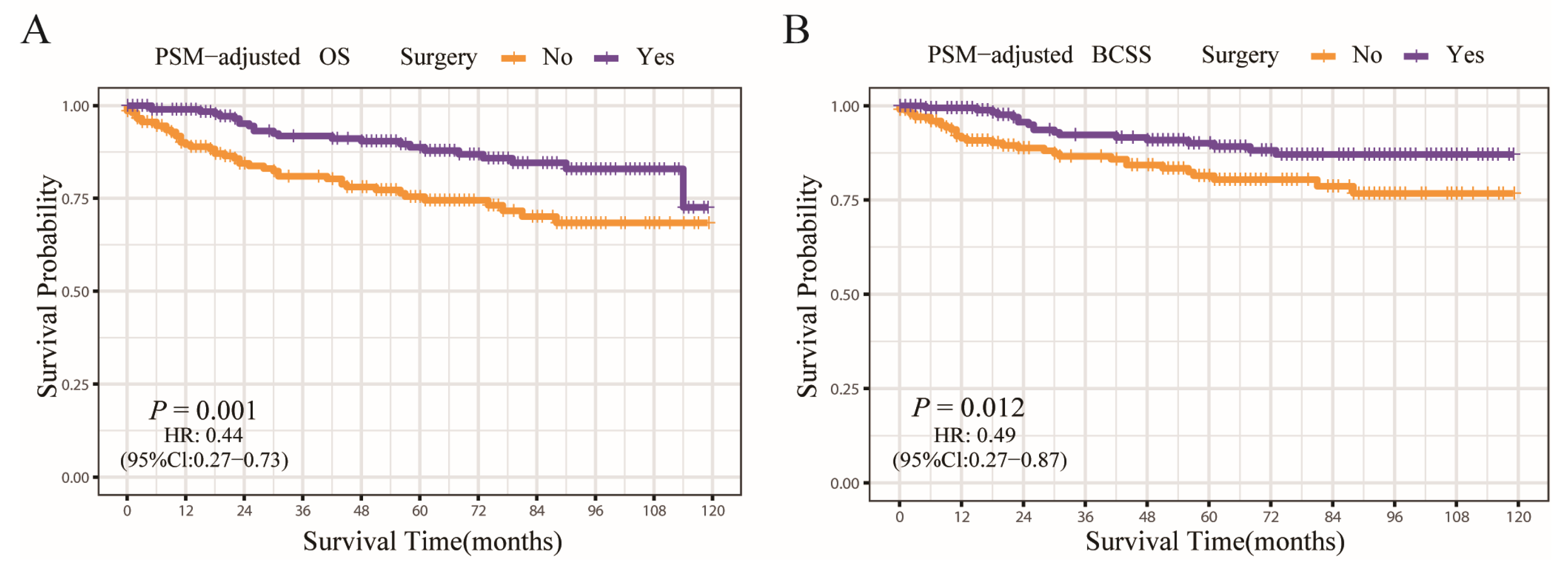

| Characteristic | Cases | % | |
|---|---|---|---|
| Age at diagnosis | <50 | 142 | 15.67% |
| 50–59 | 247 | 27.26% | |
| 60–69 | 252 | 27.81% | |
| 70–79 | 173 | 19.09% | |
| 80+ | 92 | 10.15% | |
| Months from diagnosis to therapy | 0 month | 449 | 49.56% |
| ≥1 month | 377 | 41.61% | |
| unknown | 80 | 8.83% | |
| Subtype | HR+/HER2− | 376 | 41.50% |
| HR+/HER2+ | 107 | 11.81% | |
| HR−/HER2+ | 76 | 8.39% | |
| HR−/HER2− | 146 | 16.11% | |
| unknown | 201 | 22.19% | |
| Race | white | 731 | 80.68% |
| black | 95 | 10.49% | |
| other | 74 | 8.17% | |
| unknown | 6 | 0.66% | |
| Histological type | IDC | 277 | 30.57% |
| ILC | 78 | 8.61% | |
| other | 551 | 60.82% | |
| Marital status | married | 452 | 49.89% |
| singled | 134 | 14.79% | |
| divorced/other | 145 | 16.00% | |
| widowed | 145 | 16.00% | |
| unknown | 30 | 3.31% | |
| N stage | N0 | 172 | 18.98% |
| N1 | 482 | 53.20% | |
| N2 | 75 | 8.28% | |
| N3 | 104 | 11.48% | |
| unknown | 73 | 8.06% | |
| Grade | I; well differentiated | 6 | 0.66% |
| II; moderate differentiated | 28 | 3.09% | |
| III/IV; poorly differentiated | 129 | 14.24% | |
| unknown | 743 | 82.01% | |
| Median household income (inflation ajusted) | <44,999$ | 73 | 8.06% |
| 45,000–54,999$ | 121 | 13.36% | |
| 55,000–64,999$ | 215 | 23.73% | |
| 65,000–74,999$ | 208 | 22.96% | |
| 75,000$+ | 289 | 31.90% | |
| Chemotherapy | no/unknown | 325 | 35.87% |
| yes | 581 | 64.13% | |
| Radiotherapy | no/unknown | 510 | 56.29% |
| yes | 396 | 43.71% | |
| Surgery | no | 676 | 74.61% |
| yes | 222 | 24.50% | |
| unknown | 8 | 0.88% | |
| Bone metastases | no | 612 | 67.55% |
| yes | 270 | 29.80% | |
| unknown | 24 | 2.65% | |
| Liver metastases | no | 798 | 88.08% |
| yes | 81 | 8.94% | |
| unknown | 27 | 2.98% | |
| Lung metastases | no | 789 | 87.09% |
| yes | 90 | 9.93% | |
| unknown | 27 | 2.98% | |
| Brain metastases | no | 838 | 92.49% |
| yes | 39 | 4.30% | |
| unknown | 29 | 3.20% |
| Univariate Cox Analysis | Multivariate Cox Analysis | |||||||||||
|---|---|---|---|---|---|---|---|---|---|---|---|---|
| OS | BCSS | OS | BCSS | |||||||||
| HR | 95%CI | p Value | HR | 95%CI | p Value | HR | 95%CI | p Value | HR | 95%CI | p Value | |
| Age at dignosis | ||||||||||||
| <50 | reference | reference | reference | reference | ||||||||
| 50–59 | 1.338 | 0.9089–1.970 | 0.14 | 1.439 | 0.9340–2.216 | 0.099 | 0.79 | 0.4593–1.3585 | 0.39 | 0.7589 | 0.4224–1.3634 | 0.36 |
| 60–69 | 1.744 | 1.1980–2.538 | ** | 1.474 | 0.9554–2.275 | 0.079 | 1.1716 | 0.6870–1.9979 | 0.56 | 0.9772 | 0.5434–1.7572 | 0.94 |
| 70–79 | 2.195 | 1.4956–3.221 | *** | 2.015 | 1.2990–3.125 | ** | 1.3483 | 0.7734–2.3508 | 0.29 | 1.2467 | 0.6879–2.2593 | 0.47 |
| 80+ | 4.59 | 3.0608–6.882 | *** | 3.645 | 2.2560–5.888 | *** | 2.1283 | 1.0377–4.3651 | * | 1.5213 | 0.7263–3.1868 | 0.27 |
| Months from diagnosis to therapy | ||||||||||||
| 0 month | reference | reference | / | / | / | / | / | / | ||||
| ≥1 month | 1.085 | 0.8694–1.353 | 0.47 | 1.075 | 0.8335–1.388 | 0.57 | / | / | / | / | / | / |
| Subtypes | ||||||||||||
| HR+/HER2− | reference | reference | reference | reference | ||||||||
| HR+/HER2+ | 0.5526 | 0.3583–0.8523 | ** | 0.6496 | 0.4018–1.050 | 0.078 | 0.8763 | 0.5335–1.4395 | 0.60 | 1.0001 | 0.5760–1.7363 | 1.0 |
| HR−/HER2+ | 0.8551 | 0.5586–1.3088 | 0.47 | 0.9111 | 0.5578–1.488 | 0.71 | 0.8652 | 0.4985–1.5016 | 0.61 | 0.9611 | 0.5259–1.7564 | 0.90 |
| HR−/HER2− | 1.1147 | 0.8188–1.5177 | 0.49 | 1.2257 | 0.8594–1.748 | 0.26 | 1.9999 | 1.3739–2.9111 | *** | 2.6362 | 1.7191- 4.0426 | *** |
| Race | ||||||||||||
| white | reference | reference | / | / | / | / | / | / | ||||
| black | 0.8584 | 0.6055–1.217 | 0.39 | 0.738 | 0.4767–1.143 | 0.17 | / | / | / | / | / | / |
| other | 0.8479 | 0.5642–1.274 | 0.43 | 0.8337 | 0.5161–1.347 | 0.46 | / | / | / | / | / | / |
| Histological type | ||||||||||||
| IDC | reference | reference | reference | reference | ||||||||
| ILC | 2.951 | 2.036–4.276 | *** | 3.267 | 2.178–4.899 | *** | 1.5221 | 0.8794–2.6345 | 0.13 | 2.0359 | 1.1437–3.6242 | * |
| other | 1.875 | 1.434–2.452 | *** | 1.586 | 1.167–2.156 | ** | 0.8826 | 0.6165–1.2634 | 0.49 | 0.7979 | 0.5335–1.1933 | 0.27 |
| Marriage status | ||||||||||||
| married | reference | reference | reference | / | / | / | ||||||
| divorced/separated/other | 1.191 | 0.8917–1.591 | 0.24 | 1.105 | 0.7873–1.551 | 0.56 | 1.1943 | 0.8067–1.7680 | 0.38 | / | / | / |
| single | 1.272 | 0.9457–1.711 | 0.11 | 1.126 | 0.7898–1.605 | 0.51 | 1.0995 | 0.7145–1.6920 | 0.67 | / | / | / |
| widowed | 1.522 | 1.1612–1.996 | ** | 1.281 | 0.9222–1.779 | 0.14 | 0.7685 | 0.4741–1.2456 | 0.67 | / | / | / |
| widowed/divorced/other | ||||||||||||
| N Stage | ||||||||||||
| N0 | reference | reference | reference | reference | ||||||||
| N1 | 0.3618 | 0.28350–0.4616 | *** | 0.3474 | 0.26222–0.4604 | *** | 0.6602 | 0.4568–0.9542 | * | 0.5671 | 0.3734–0.8612 | ** |
| N2 | 0.1695 | 0.09877–0.2907 | *** | 0.1321 | 0.06642–0.2628 | *** | 0.4716 | 0.2351–0.9464 | * | 0.3411 | 0.1456–0.7991 | * |
| N3 | 0.3757 | 0.25815–0.5468 | *** | 0.4095 | 0.27027–0.6206 | *** | 0.9892 | 0.6176–1.5844 | 0.96 | 1.0411 | 0.6160–1.7595 | 0.88 |
| Grade | ||||||||||||
| well differentiated | reference | reference | / | / | / | / | / | / | ||||
| moderately differentiated | 2.73 | 0.3518–21.18 | 0.34 | / | / | / | / | / | / | / | / | / |
| poorly differentiated | 2.271 | 0.3118–16.54 | 0.42 | / | / | / | / | / | / | / | / | / |
| Median household income (inflation ajusted) | ||||||||||||
| <45,000$ | reference | reference | / | / | / | / | / | / | ||||
| 45,000–54,999$ | 0.9608 | 0.6266–1.473 | 0.85 | 0.8186 | 0.4983–1.345 | 0.43 | / | / | / | / | / | / |
| 55,000–64,999$ | 0.8483 | 0.5717–1.259 | 0.41 | 0.7758 | 0.4949–1.216 | 0.27 | / | / | / | / | / | / |
| 65,000–74,999$ | 0.701 | 0.4634–1.060 | 0.093 | 0.6992 | 0.4385–1.115 | 0.13 | / | / | / | / | / | / |
| >74,999$ | 0.8262 | 0.5619–1.215 | 0.33 | 0.714 | 0.4592–1.110 | 0.14 | / | / | / | / | / | / |
| Chemotherapy | ||||||||||||
| no/unknown | reference | reference | reference | reference | ||||||||
| yes | 0.3753 | 0.3065–0.4594 | *** | 0.447 | 0.3525–0.567 | *** | 0.7487 | 0.5273–1.0632 | 0.11 | 0.8836 | 0.5923–1.3181 | 0.54 |
| Radiotherapy | ||||||||||||
| no/unknown | reference | reference | reference | reference | ||||||||
| yes | 0.4247 | 0.3397–0.5308 | *** | 0.4806 | 0.3719–0.621 | *** | 0.6773 | 0.4939–0.9289 | * | 0.8091 | 0.5692–1.1503 | 0.24 |
| Surgery | ||||||||||||
| no/unknown | reference | reference | reference | reference | ||||||||
| yes | 0.1427 | 0.09428–0.216 | *** | 0.1583 | 0.09917–0.2526 | *** | 0.4271 | 0.2609–0.6990 | *** | 0.4491 | 0.2593–0.7777 | ** |
| Bone metastasis | ||||||||||||
| no/unknown | reference | reference | ||||||||||
| yes | 3.568 | 2.892–4.402 | *** | 4.121 | 3.216–5.281 | *** | 2.0779 | 1.4807–2.9161 | *** | 2.5002 | 1.6968–3.6839 | *** |
| Liver metastasis | ||||||||||||
| no/unknown | reference | reference | reference | reference | ||||||||
| yes | 4.443 | 3.358–5.877 | *** | 4.553 | 3.279–6.322 | *** | 2.4709 | 1.5316–3.9863 | *** | 2.604 | 1.5423–4.3963 | *** |
| Lung metastasis | ||||||||||||
| no/unknown | reference | reference | reference | reference | ||||||||
| yes | 4.03 | 3.106–5.229 | *** | 3.432 | 2.483–4.745 | *** | 2.572 | 1.7343–3.8142 | *** | 2.4935 | 1.5642–3.9748 | *** |
| Brain metastasis | ||||||||||||
| no/unknown | reference | reference | reference | reference | ||||||||
| yes | 2.83 | 1.933–4.142 | *** | 2.876 | 1.838- 4.5 | *** | 2.3986 | 1.3387–4.2976 | ** | 2.0765 | 1.0757–4.0083 | * |
| 1-Year Survival | 3-Year Survival | 5-Year Survival | |
|---|---|---|---|
| LR | 0.851 | 0.790 | 0.824 |
| RF | 0.818 | 0.765 | 0.824 |
| XGBoost | 0.795 | 0.792 | 0.829 |
| ID3 | 0.665 | 0.755 | 0.788 |
| KNN | 0.773 | 0.711 | 0.784 |
| SVM | 0.550 | 0.676 | 0.766 |
| Characteristics | Unmatched Cohort | 1:1 Propensity Score Matched (PSM) Cohort | ||||||||
|---|---|---|---|---|---|---|---|---|---|---|
| Chemotherapy Not Given | Chemotherapy | Unadjusted | Chemotherapy Not Given | Chemotherapy | PSM-Adjusted | |||||
| N = 325 | % | N = 581 | % | p Value | N = 234 | % | N = 234 | % | p Value | |
| Age at diagnosis | *** | 0.462 | ||||||||
| <50 | 22 | 6.77% | 120 | 20.65% | 21 | 8.97% | 31 | 13.25% | ||
| 50–59 | 68 | 20.92% | 179 | 30.81% | 57 | 24.36% | 64 | 27.35% | ||
| 60–69 | 82 | 25.23% | 170 | 29.26% | 71 | 30.34% | 67 | 28.63% | ||
| 70–79 | 85 | 26.15% | 88 | 15.15% | 56 | 23.93% | 49 | 20.94% | ||
| 80+ | 68 | 20.92% | 24 | 4.13% | 29 | 12.39% | 23 | 9.83% | ||
| Subtype | *** | 0.586 | ||||||||
| HR+/HER2− | 149 | 45.85% | 227 | 39.07% | 114 | 48.72% | 104 | 44.44% | ||
| HR+/HER2+ | 16 | 4.92% | 91 | 15.66% | 16 | 6.84% | 24 | 10.26% | ||
| HR−/HER2+ | 11 | 3.38% | 65 | 11.19% | 11 | 4.70% | 13 | 5.56% | ||
| HR−/HER2− | 33 | 10.15% | 113 | 19.45% | 28 | 11.97% | 33 | 14.10% | ||
| unknown | 116 | 35.69% | 85 | 14.63% | 65 | 27.78% | 60 | 25.64% | ||
| Race | * | 0.778 | ||||||||
| white | 277 | 85.23% | 454 | 78.14% | 199 | 85.04% | 191 | 81.62% | ||
| black | 25 | 7.69% | 70 | 12.05% | 19 | 8.12% | 22 | 9.40% | ||
| other | 20 | 6.15% | 54 | 9.29% | 15 | 6.41% | 20 | 8.55% | ||
| unknown | 3 | 0.92% | 3 | 0.52% | 1 | 0.43% | 1 | 0.43% | ||
| Histological type | *** | 0.668 | ||||||||
| IDC | 64 | 19.69% | 213 | 36.66% | 51 | 21.79% | 57 | 24.36% | ||
| ILC | 37 | 11.38% | 41 | 7.06% | 29 | 12.39% | 24 | 10.26% | ||
| other | 224 | 68.92% | 327 | 56.28% | 154 | 65.81% | 153 | 65.38% | ||
| Marital status | *** | 0.893 | ||||||||
| married | 129 | 39.69% | 323 | 55.59% | 104 | 44.44% | 107 | 45.73% | ||
| divorced/separated/other | 52 | 16.00% | 93 | 16.01% | 40 | 17.09% | 44 | 18.80% | ||
| single | 51 | 15.69% | 83 | 14.29% | 35 | 14.96% | 37 | 15.81% | ||
| widowed | 79 | 24.31% | 66 | 11.36% | 46 | 19.66% | 38 | 16.24% | ||
| unknown | 14 | 4.31% | 16 | 2.75% | 9 | 3.85% | 8 | 3.42% | ||
| N stage | *** | 0.099 | ||||||||
| N0 | 111 | 34.15% | 61 | 10.50% | 59 | 25.21% | 49 | 20.94% | ||
| N1 | 131 | 40.31% | 351 | 60.41% | 115 | 49.15% | 119 | 50.85% | ||
| N2 | 9 | 2.77% | 66 | 11.36% | 9 | 3.85% | 23 | 9.83% | ||
| N3 | 27 | 8.31% | 77 | 13.25% | 25 | 10.68% | 21 | 8.97% | ||
| unknown | 47 | 14.46% | 26 | 4.48% | 26 | 11.11% | 22 | 9.40% | ||
| Grade | *** | 0.076 | ||||||||
| well | 0 | 0.00% | 6 | 1.03% | 0 | 0.00% | 4 | 1.71% | ||
| moderately | 3 | 0.92% | 25 | 4.30% | 3 | 1.28% | 6 | 2.56% | ||
| poorly | 21 | 6.46% | 108 | 18.59% | 20 | 8.55% | 28 | 11.97% | ||
| unknown | 301 | 92.62% | 442 | 76.08% | 211 | 90.17% | 196 | 83.76% | ||
| Median household income (inflation adjusted) | 0.133 | 0.532 | ||||||||
| <45,000$ | 32 | 9.85% | 41 | 7.06% | 24 | 10.26% | 16 | 6.84% | ||
| 45,000–54,999$ | 44 | 13.54% | 77 | 13.25% | 31 | 13.25% | 30 | 12.82% | ||
| 55,000–64,999$ | 86 | 26.46% | 129 | 22.20% | 64 | 27.35% | 59 | 25.21% | ||
| 65,000–74,999$ | 62 | 19.08% | 146 | 25.13% | 42 | 17.95% | 53 | 22.65% | ||
| >74,999$ | 101 | 31.08% | 188 | 32.36% | 73 | 31.20% | 76 | 32.48% | ||
| Surgery | *** | 0.254 | ||||||||
| no | 295 | 90.77% | 381 | 65.58% | 209 | 89.32% | 197 | 84.19% | ||
| yes | 24 | 7.38% | 198 | 34.08% | 24 | 10.26% | 35 | 14.96% | ||
| unknown | 6 | 1.85% | 2 | 0.34% | 1 | 0.43% | 2 | 0.85% | ||
| Radiotherapy | *** | 0.556 | ||||||||
| no/unknown | 245 | 75.38% | 265 | 45.61% | 160 | 68.38% | 153 | 65.38% | ||
| yes | 80 | 24.62% | 316 | 54.39% | 74 | 31.62% | 81 | 34.62% | ||
| Bone metastases | *** | 1 | ||||||||
| no | 160 | 49.23% | 452 | 77.80% | 137 | 58.55% | 137 | 58.55% | ||
| yes | 149 | 45.85% | 121 | 20.83% | 90 | 38.46% | 90 | 38.46% | ||
| unknown | 16 | 4.92% | 8 | 1.38% | 7 | 2.99% | 7 | 2.99% | ||
| Liver metastases | *** | 0.908 | ||||||||
| no | 273 | 84.00% | 525 | 90.36% | 202 | 86.32% | 199 | 85.04% | ||
| yes | 33 | 10.15% | 48 | 8.26% | 25 | 10.68% | 28 | 11.97% | ||
| unknown | 19 | 5.85% | 8 | 1.38% | 7 | 2.99% | 7 | 2.99% | ||
| Lung metastases | *** | 0.876 | ||||||||
| no | 255 | 78.46% | 534 | 91.91% | 196 | 83.76% | 200 | 85.47% | ||
| yes | 52 | 16.00% | 38 | 6.54% | 30 | 12.82% | 27 | 11.54% | ||
| unknown | 18 | 5.54% | 9 | 1.55% | 8 | 3.42% | 7 | 2.99% | ||
| Brain metastases | * | 0.979 | ||||||||
| no | 293 | 90.15% | 545 | 93.80% | 214 | 91.45% | 214 | 91.45% | ||
| yes | 14 | 4.31% | 25 | 4.30% | 12 | 5.13% | 13 | 5.56% | ||
| unknown | 18 | 5.54% | 11 | 1.89% | 8 | 3.42% | 8 | 3.42% | ||
| Characteristics | Unmatched Cohort | 1:1 Propensity Score Matched (PSM) Cohort | ||||||||
|---|---|---|---|---|---|---|---|---|---|---|
| Surgery Not Given | Surgery | Unadjusted | Surgery Not Given | Surgery | PSM-Adjusted | |||||
| N = 676 | % | N = 222 | % | p Value | N = 209 | % | N = 209 | % | p Value | |
| Age at diagnosis | *** | 0.089 | ||||||||
| <50 | 74 | 10.95% | 67 | 30.18% | 36 | 17.22% | 56 | 26.79% | ||
| 50–59 | 174 | 25.74% | 71 | 31.98% | 77 | 36.84% | 69 | 33.01% | ||
| 60–69 | 191 | 28.25% | 57 | 25.68% | 70 | 33.49% | 57 | 27.27% | ||
| 70–79 | 149 | 22.04% | 23 | 10.36% | 18 | 8.61% | 23 | 11.00% | ||
| 80+ | 88 | 13.02% | 4 | 1.80% | 8 | 3.83% | 4 | 1.91% | ||
| Subtype | *** | 0.894 | ||||||||
| HR+/HER2− | 283 | 41.86% | 88 | 39.64% | 79 | 37.80% | 84 | 40.19% | ||
| HR+/HER2+ | 70 | 10.36% | 37 | 16.67% | 34 | 16.27% | 37 | 17.70% | ||
| HR−/HER2+ | 51 | 7.54% | 25 | 11.26% | 20 | 9.57% | 22 | 10.53% | ||
| HR−/HER2− | 99 | 14.64% | 45 | 20.27% | 47 | 22.49% | 40 | 19.14% | ||
| unknown | 173 | 25.59% | 27 | 12.16% | 29 | 13.88% | 26 | 12.44% | ||
| Race | 0.303 | 0.112 | ||||||||
| white | 555 | 82.10% | 171 | 77.03% | 149 | 71.29% | 161 | 77.03% | ||
| black | 68 | 10.06% | 26 | 11.71% | 37 | 17.70% | 25 | 11.96% | ||
| other | 49 | 7.25% | 24 | 10.81% | 20 | 9.57% | 23 | 11.00% | ||
| unknown | 4 | 0.59% | 1 | 0.45% | 3 | 1.44% | 0 | 0.00% | ||
| Histological type | *** | 0.671 | ||||||||
| IDC | 165 | 24.41% | 109 | 49.10% | 91 | 43.54% | 100 | 47.85% | ||
| ILC | 71 | 10.50% | 5 | 2.25% | 5 | 2.39% | 5 | 2.39% | ||
| other | 440 | 65.09% | 108 | 48.65% | 113 | 54.07% | 104 | 49.76% | ||
| Marital status | 0.075 | 0.995 | ||||||||
| married | 322 | 47.63% | 128 | 57.66% | 118 | 56.46% | 119 | 56.94% | ||
| divorcedsSeparated/other | 111 | 16.42% | 30 | 13.51% | 27 | 12.92% | 28 | 13.40% | ||
| single | 102 | 15.09% | 32 | 14.41% | 31 | 14.83% | 32 | 15.31% | ||
| widowed | 119 | 17.60% | 25 | 11.26% | 27 | 12.92% | 24 | 11.48% | ||
| unknown | 22 | 3.25% | 7 | 3.15% | 6 | 2.87% | 6 | 2.87% | ||
| N stage | *** | 0.688 | ||||||||
| N0 | 166 | 24.56% | 6 | 2.70% | 4 | 1.91% | 6 | 2.87% | ||
| N1 | 331 | 48.96% | 145 | 65.32% | 144 | 68.90% | 136 | 65.07% | ||
| N2 | 38 | 5.62% | 37 | 16.67% | 26 | 12.44% | 33 | 15.79% | ||
| N3 | 70 | 10.36% | 34 | 15.32% | 35 | 16.75% | 34 | 16.27% | ||
| unknown | 71 | 10.50% | 0 | 0.00% | 0 | 0.00% | 0 | 0.00% | ||
| Grade | *** | 0.321 | ||||||||
| well | 2 | 0.30% | 4 | 1.80% | 2 | 0.96% | 4 | 1.91% | ||
| moderately | 15 | 2.22% | 13 | 5.86% | 6 | 2.87% | 12 | 5.74% | ||
| poorly | 71 | 10.50% | 56 | 25.23% | 43 | 20.57% | 48 | 22.97% | ||
| unknown | 588 | 86.98% | 149 | 67.12% | 158 | 75.60% | 145 | 69.38% | ||
| Median household income (inflation adjusted) | 0.659 | 0.437 | ||||||||
| <45,000$ | 49 | 7.25% | 19 | 8.56% | 14 | 6.70% | 18 | 8.61% | ||
| 45,000–54,999$ | 87 | 12.87% | 34 | 15.32% | 21 | 10.05% | 32 | 15.31% | ||
| 55,000–64,999$ | 159 | 23.52% | 55 | 24.77% | 53 | 25.36% | 53 | 25.36% | ||
| 65,000–74,999$ | 157 | 23.22% | 51 | 22.97% | 54 | 25.84% | 47 | 22.49% | ||
| >74,999$ | 224 | 33.14% | 63 | 28.38% | 67 | 32.06% | 59 | 28.23% | ||
| Chemothrapy | *** | 0.466 | ||||||||
| no/unknown | 295 | 43.64% | 24 | 10.81% | 30 | 14.35% | 24 | 11.48% | ||
| yes | 381 | 56.36% | 198 | 89.19% | 179 | 85.65% | 185 | 88.52% | ||
| Radiotherapy | *** | 0.768 | ||||||||
| no/unknown | 407 | 60.21% | 96 | 43.24% | 90 | 43.06% | 94 | 44.98% | ||
| yes | 269 | 39.79% | 126 | 56.76% | 119 | 56.94% | 115 | 55.02% | ||
| Bone metastases | *** | 1 | ||||||||
| no | 393 | 58.14% | 216 | 97.30% | 205 | 98.09% | 203 | 97.13% | ||
| yes | 265 | 39.20% | 3 | 1.35% | 1 | 0.48% | 3 | 1.44% | ||
| unknown | 18 | 2.66% | 3 | 1.35% | 3 | 1.44% | 3 | 1.44% | ||
| Liver metastases | *** | 0.604 | ||||||||
| no | 576 | 85.21% | 218 | 98.20% | 206 | 98.56% | 205 | 98.09% | ||
| yes | 79 | 11.69% | 1 | 0.45% | 1 | 0.48% | 1 | 0.48% | ||
| unknown | 21 | 3.11% | 3 | 1.35% | 3 | 1.44% | 3 | 1.44% | ||
| Lung metastases | *** | 0.6 | ||||||||
| no | 568 | 84.02% | 216 | 97.30% | 200 | 95.69% | 203 | 97.13% | ||
| yes | 86 | 12.72% | 3 | 1.35% | 6 | 2.87% | 3 | 1.44% | ||
| unknown | 22 | 3.25% | 3 | 1.35% | 3 | 1.44% | 3 | 1.44% | ||
| Brain metastases | ** | 0.784 | ||||||||
| no | 617 | 91.27% | 216 | 97.30% | 205 | 98.09% | 203 | 97.13% | ||
| yes | 37 | 5.47% | 2 | 0.90% | 1 | 0.48% | 2 | 0.96% | ||
| unknown | 22 | 3.25% | 4 | 1.80% | 3 | 1.44% | 4 | 1.91% | ||
Disclaimer/Publisher’s Note: The statements, opinions and data contained in all publications are solely those of the individual author(s) and contributor(s) and not of MDPI and/or the editor(s). MDPI and/or the editor(s) disclaim responsibility for any injury to people or property resulting from any ideas, methods, instructions or products referred to in the content. |
© 2023 by the authors. Licensee MDPI, Basel, Switzerland. This article is an open access article distributed under the terms and conditions of the Creative Commons Attribution (CC BY) license (https://creativecommons.org/licenses/by/4.0/).
Share and Cite
Qu, J.; Li, C.; Liu, M.; Wang, Y.; Feng, Z.; Li, J.; Wang, W.; Wu, F.; Zhang, S.; Zhao, X. Prognostic Models Using Machine Learning Algorithms and Treatment Outcomes of Occult Breast Cancer Patients. J. Clin. Med. 2023, 12, 3097. https://doi.org/10.3390/jcm12093097
Qu J, Li C, Liu M, Wang Y, Feng Z, Li J, Wang W, Wu F, Zhang S, Zhao X. Prognostic Models Using Machine Learning Algorithms and Treatment Outcomes of Occult Breast Cancer Patients. Journal of Clinical Medicine. 2023; 12(9):3097. https://doi.org/10.3390/jcm12093097
Chicago/Turabian StyleQu, Jingkun, Chaofan Li, Mengjie Liu, Yusheng Wang, Zeyao Feng, Jia Li, Weiwei Wang, Fei Wu, Shuqun Zhang, and Xixi Zhao. 2023. "Prognostic Models Using Machine Learning Algorithms and Treatment Outcomes of Occult Breast Cancer Patients" Journal of Clinical Medicine 12, no. 9: 3097. https://doi.org/10.3390/jcm12093097
APA StyleQu, J., Li, C., Liu, M., Wang, Y., Feng, Z., Li, J., Wang, W., Wu, F., Zhang, S., & Zhao, X. (2023). Prognostic Models Using Machine Learning Algorithms and Treatment Outcomes of Occult Breast Cancer Patients. Journal of Clinical Medicine, 12(9), 3097. https://doi.org/10.3390/jcm12093097







